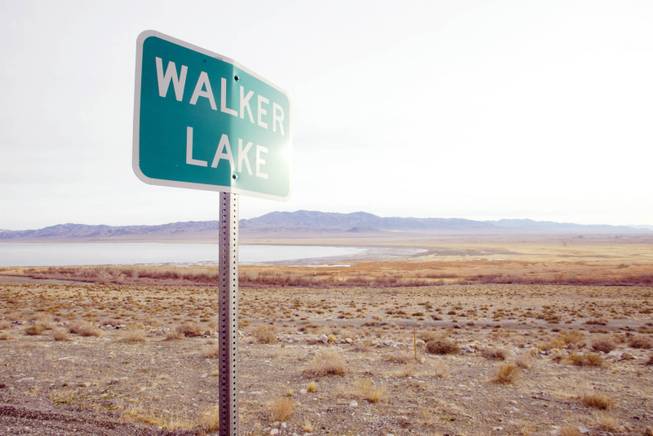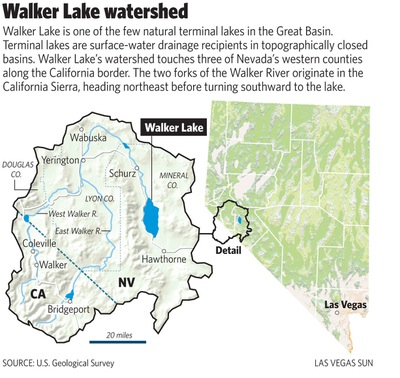
A road sign announces Walker Lake near the receding lake’s south end in 2003.
Tuesday, July 8, 2008 | 2 a.m.
Sun Archives
Beyond the Sun
“Lakefront land sale,” screamed the advertisement, “one weekend only.”
The pitch promised migrating loons and renowned Lahontan cutthroat trout fishing on Walker Lake, five hours from Las Vegas near Hawthorne.
What the fine print failed to mention was that this is the same Walker Lake in which the water level has dropped 140 feet in the past 120 years, the same lake that’s so saline every species of fish but the Lahontan cutthroat has all but died off. It’s the same lake that fishermen and loon lovers have been trying to rescue for the past two decades, a lake many have declared dead.
Picture unhappy customers standing at their property lines watching their lifeless lake recede into the distance.
But Nevada Land and Ranches — the company selling one-acre parcels, with lakefront lots going for $149,900 and lots with views but no shoreline for $49,900 — says the rumors of Walker Lake’s demise are much exaggerated.
Jannette Shambaugh, who works in the company’s acquisitions department, says part of her job is educating potential buyers because “people say the lake is dying, but it’s not.”
It’s true the likes of Senate Majority Leader Harry Reid are going to bat for Walker Lake, working with local groups on federal legislation that would provide funding to buy or lease 50,000 acre-feet of water rights on the Walker River to supplement lake levels. Once the lake level were to rise more than 30 feet, it would take 25,000 acre-feet to keep it up, experts say.
And the Nevada Wildlife Department and the federal Fish and Wildlife Service stock the waters with tens of thousands of fish every year, introducing them into the Walker River upstream of the lake so they have time to acclimate to the lake’s less-than-hospitable environment.
“I just would hate to say something to perpetuate the sense that Walker Lake is dead,” said Kim Tisdale, supervising fisheries biologist for the Wildlife Department. “It is not. But obviously its future is tentative.”
Shambaugh calls the lake “a gem in the desert” and extols the virtues of its sand beach, its rock-free shoreline and its sweeping views.
“They are not going to let that lake go away,” said Audrey Kennoch, owner of Nevada Land and Ranches, which is selling 29 parcels along the lake in a subdivision called The Shores at Walker Lake. “With all the government agencies in place, I just would never believe they would let that lake go away.”
Still, the lake recedes to reveal another yard or so of shoreline every year, according to Tisdale.
Walker Lake Working Group, a local organization, has searched for solutions to the moving shoreline for nearly two decades. Its chairman, Lou Thompson, said he was surprised to see the lakefront land sale ad.
“Our ‘renowned Lahontan cutthroat trout fishing’ no longer exists. They may die out this year or next without appreciable water coming in (to the lake),” he said. “But we haven’t had a trophy fishery since the ’60s or ’70s.”
That’s because of the level of “total dissolved solids” in the lake. It’s the same thing that leaves the white mineral bathtub ring around Lake Mead. When the water evaporated from the lake and wasn’t replaced by rainfall or water flowing in from the Walker River (because the river water was being used upstream for irrigation), the concentration of those minerals intensified until it was toxic to the fish.
That’s one of the reasons the Wildlife Department started tagging and monitoring every fish it puts into the lake two years ago.
“To be truthful with you, everyone is in agreement that they don’t know why (the lake) still has fish in it at all,” said Glenn Bunch, Working Group vice chairman and past chairman of the Mineral County Planning Commission. “There used to be 14- to 20-pound fish. Now you’re doing good to catch a 4-pounder.”
Kennoch counters that Walker Lake has to be considered in the context of the lakefront land market in Nevada. Lake Mead levels are down, too, not that anyone can buy land there anyway, and Lake Tahoe is just too expensive for most people.
Walker “is a beautiful lake and it’s huge and if it drops a little bit over the next 50 years I don’t see it as that much of a problem,” she said. “But I don’t believe that’s going to happen because there are great efforts out there to save the lake.”
The seven customers Shambaugh spent the last weekend in June swimming and paddle boating with — and who plan to buy lots in the Shores development — probably hope so.
And though the future of the lake is anything but certain at this point, Shelley Hartmann, executive director of economic development for the Mineral County Chamber of Commerce, Bunch and even Thompson say the county needs more housing, more development.
Jon Summers, a spokesman for Reid, called the land sale encouraging, a sign that people are willing to invest in the future of the lake.
Hartmann even worries that if efforts to raise the lake level are successful, lakeside dwellers might wind up encountering the opposite problem — water lapping at their doorsteps instead of slipping slowly from them.
That’s unlikely considering the lots are behind what’s called a meander line, or the shoreline from high-water year 1997, when lake levels were about 100 feet above where they are now, according to Bunch.
About five years prior, activists had begun working to save the lake, and Reid’s office has been involved almost as long.
Advocates for the lake figure a few more shore dwellers fighting to save it couldn’t hurt.


Join the Discussion:
Check this out for a full explanation of our conversion to the LiveFyre commenting system and instructions on how to sign up for an account.
Full comments policy